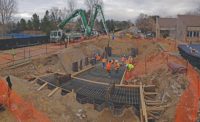Design-Build Services for Kettle Creek Flow Control Valve Project
Colorado Springs
Best Project
Owner: Colorado Springs Utilities
Lead Design Firm & Structural/Civil Engineer: Dewberry
General Contractor: Garney Cos.
Engineer: AECOM
Subcontractors: American Pipeline Services; Applewood Painting Co.; Berwick Electric; CWI; Horizon Mechanical Solutions; LT Environmental Inc.; Mountain Man Welding & Fabrication; Total Terrain Inc.
The Kettle Creek Flow Control Valve Design-Build project was developed to replace a single 30-in. plug valve and create a redundant flow train between two major potable water pipelines.
The plug valve was installed in 1984 to allow operational flexibility for moving water to the northeast side or to the south and central sides of Colorado Springs. A large amount of Colorado Springs Utilities’ potable water flows through the pipelines during the summer to meet water needs in those areas.
In 2015, the aging plug valve failed in a 25% open position, creating a bottleneck for flows to reach different areas of the city. Upgrading the valve soon became the utility’s top priority and the most critical valve replacement in recent history for its public water system.
The project was carried out in three phases, which included design and project development, critical and international material procurement, and final design and construction.
The project team planned, designed and procured materials for 11 months prior to a planned shutdown to do the work. The 72-hour shutdown was broken down into three phases.
Phase 1 consisted of 24 hours to prepare the water system for shutdown. This included setup of four portable pumps to move nearly 10 million gallons of water per day to different pressure zones. Once this was complete, crews then needed to drain more than three miles of 60-in. pipe and four miles of 48-in. pipe to 42-in. pipe in order to install eight new isolation valves around the Kettle Creek site. That installation would facilitate replacement of the 30-in. plug valve and creation of the new valve vault for system redundancy.
Phase 2 consisted of 24 hours to install seven critical isolation valves ranging from 48 in. to 12 in. in diameter. Welders ensured that each of the valves was installed on new steel pipe connections.
Phase 3 consisted of 24 hours for crews to place the system back into service.
With the combined efforts of 75 people working together, the 72-hour shutdown was completed ahead of schedule, and the city’s water supply was not interrupted throughout the planning, design or construction phases.
Back to "Annual Awards Competition Attracts the Most Entries in Its History"




Post a comment to this article
Report Abusive Comment